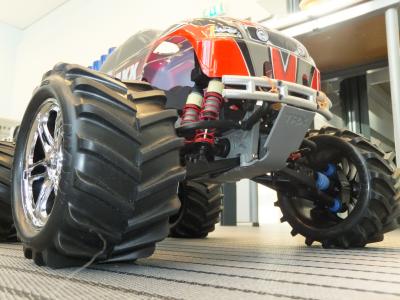EE2L1 Integrated Project 3
This 2nd year BSc practical consists of two parts:
- Two Python computer exercises, which continue the course labs of EE2S1 Signals and Systems:
- recording dual-microphone audio signals
- deconvolution (matched filter, frequency domain approach)
- application to estimating the distance between two microphones using an audio signal
- Design of a complex system, with the choice of two projects: A. KITT self-driving car, or B. Electronic stethoscope
A In this project you team with your fellow students to remotely operate an electric toy car called "KITT". The car is equipped with ultrasonic parking sensors, a Bluetooth connection, an audio beacon and a micro-controller. You are in charge of this "enhanced" car and will design and implement algorithms so that the car can localize itself, sense obstacles and find its way autonomously; as well as to communicate with a base station at which calculations are performed. High tracking accuracy and speedy and tight control are your objectives. In a series of competitions you and your team will show your achievements in challenges of increasing difficulty.
B In this project you work with a 6-channel digital stethoscope array. The first objective is to capture heart signals, filter and analyse the signals (anomaly detection such as murmurs). The next objective is to localize the sources (e.g., the 4 valves) using deconvolution, TDOA estimation, and MUSIC-like (eigenvalue-based) algorithms. The algorithms are designed and tested on a dummy. After consideration of the ethical aspects, the signals could also be acquired on human subjects.
The projects contain a midterm report and are wrapped up by a demo session and a final report, followed by a presentation/discussion in front of a committee.
Study Goals
After following this course you should be able to:
- Analyze a real-world application which involves both hardware and software by breaking it down into smaller modules.
- Apply signal processing (and linear algebra, statistics, modeling, communication, control) tools to design and implement the solution using the python programming language.
- Design a complex system using design methodology as developed over the various IP labs.
- Plan, manage and conduct effective teamwork for the successful realization of a technical complex assignment.
- Write and present a technical report that complies with current standards of the electrical engineering scientific community.
- Reflect on ethical aspects associated with the application of the designed system in society.
Teachers
prof.dr.ir. Alle-Jan van der Veen
Array signal processing; Signal processing for communications
MSc Bahareh Abdi
Biomedical signal processing
Last modified: 2024-09-04

Details
| Credits: | 5 EC |
|---|---|
| Period: | 0/8/0/0 |
| Contact: | Alle-Jan van der Veen |